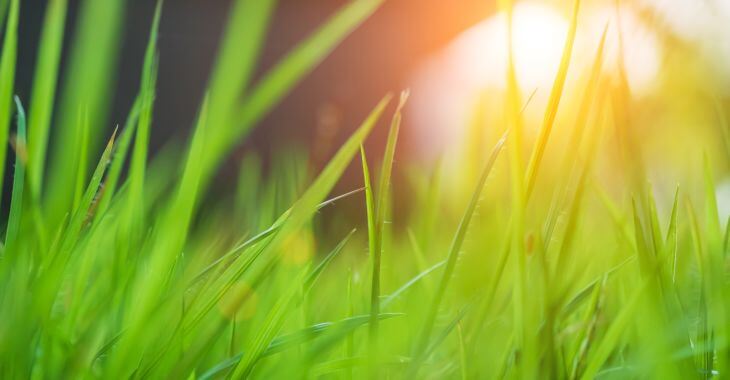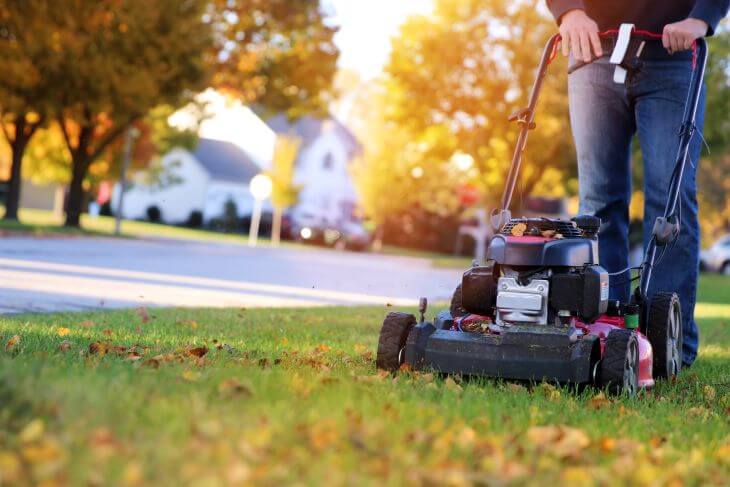When Does Grass Stop Growing Each Year?

Grass seems to grow fast during the spring, summer and early fall– within a day or two after mowing, the blades already seem longer. However, grass does not grow at this speed year-round, even in climates without harsh winters. When does grass stop growing and when is it time to stop mowing each year? The exact time depends on the type of grass and region where you live, as well as other factors. Here are the basics on grass growing cycles and how to best care for your lawn in the late fall and early winter.
Grass Growing Cycles
Grass stays alive all year round, even when it is not growing. The soil temperature, not the calendar, is the key to determining when the grass begins to “green-up” in the spring, and when the grass stops growing and goes dormant during the winter. Grass can begin growing in late winter or early spring, usually as soon as the sun begins warming the topsoil. Grass grows steadily during the spring, summer and fall as long as it receives enough nourishment. When does grass stop growing? That can depend on the type of grass and climate.
There are different types of grasses that are better suited to different climates. Most grasses grown for lawn or turf go dormant during the winter season when the soil temperature changes. Cool-season grasses begin their dormant phase when the soil temperature stays below 45 degrees; warm-season grasses go dormant when soil is consistently below 55 degrees. While fall may be cooler, grass actually can grow faster in early and mid-autumn. The cooler weather can stimulate growth until the temperatures become low enough to chill the soil.
When to Stop Mowing Your Lawn
How do you know when your grass has stopped growing? Beyond checking the temperature of your soil, you can count on other signs that your grass is going dormant. For warmer climates, the temperature of the soil only needs to stay under 55 degrees, which can begin as soon as November. Cold-season grasses will begin to go dormant sooner, in some regions as early as late October. Since many other plants and trees also go dormant during the winter, the foliage in your yard can alert you to the end of the grass growing cycle.
A simple way to know when the grass is done growing is to watch your trees. Deciduous trees lose their leaves in the fall and go dormant during the winter – this usually coincides with the chilling of the soil and the grass growing cycle. As the trees begin to lose their leaves, you know the growing cycle of your grass is coming to an end. You should begin mowing your lawn shorted when about half the leaves are gone from the deciduous trees. When about 90% of leaves are gone from the trees, it is likely your grass has gone dormant.

Importance of a Final Fall Mow for Grass Health
Once the grass has stopped growing, it is time to perform your final mow for the year and let your lawn rest through the winter. While you can let your grass grow through the late fall and leave it long through the winter, it is not the best way to care for your grass. The best option is to complete a final mow on your lawn once it has stopped growing, cutting it short to prepare for dormancy. There are a few reasons why short grass is best during the winter season:
- Long grass can die due to damage from snow in the winter
- Short grass is easier for raking away leaves
- Short grass has a lower risk of disease
- Spring “green-up” is quicker with shorter grass
- Reduce fungal growth on matted long grass
The best way to work your way toward your final mow is to lower your mow deck during your last few mows in the fall – you do not want to ever remove more than a third of the grass length in one mow. The goal is to complete a final mow at about two-inches length – you want it long enough to prevent scalping or exposing roots, but short enough to prevent disease or damage during the winter. You can still continue to mow with the deck raised to mulch dead leaves, but once the grass is done growing, it will not need to be cut.
When does grass stop growing and what is the best way to care for your lawn in the fall and winter? This can vary depending on where you live and the type of grass in your lawn. To make it easier to care for your lawn, consider hiring a landscaping or lawn care service to perform your fall grass preparation to maintain a healthy lawn year-round.